The Swastika
The Scouting use of the Fylfot or Swastika
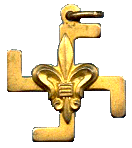 The Origin of the ‘Swastika’ Emblem
The Origin of the ‘Swastika’ Emblem
From What Scouts Can Do – More Yarns – Baden-Powell, 1921; the full text of which can be found on the excellent Pine Tree Web Site.
” … as you know from the account of the Swastika Thanks Badge which I have given to you in Scouting for Boys, the symbol was used in almost every part of the world in ancient days and therefore has various meanings given to it.
The word “swastika” is not, as many people suppose, of German origin. The name comes from the Sanskrit and is derived from Svasti, meaning well-being and prosperity. In India there is a distinction made between Swastikas that seem to rotate forward and those that seem to rotate backwards. The left-hand swastika being associated with Kali and magical practice. In Europe the design was sometimes called the Hooked Cross or, from Middle English, ‘Fylfot’.
Some people think the swastika to be a sun symbol, symbolising the sun’s annual or daily passage around the earth. As we know, it is the earth that travels round the sun, and not the other way about, but these were ancient beliefs. The emblem apparently is to be found in almost every culture and on every continent. Edyndon, the Bishop of Winchester who died in 1366, had the design emblazoned on his stole. B-P maintained that this use derived from an ancient cross of submission depicting kneeling legs. The ‘legs’ have also been likened to the four winds or the four great rivers that flowed one each from the four great continents into a central sea. The device is generally accepted to be an early symbol of fertility and productivity which, prior to the emergence of the National Socialist Party in Germany, had become a world-wide symbol of good-luck.
Swastika, the symbol of good luck.
The use of the symbol as a good luck charm was widespread throughout the western world. There are numerous examples, pre 1935 of postcards, books, charms, lucky ‘coins’ all carrying the design
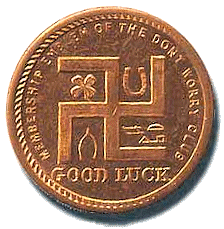
US John Deere ‘token’ showing various good luck ‘charms’
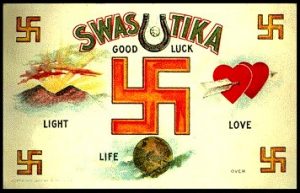
What could be more innocent? 1907 Postcard
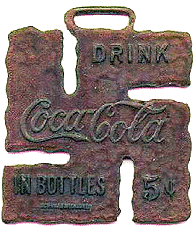
Coca Cola advertising

Kipling Bookspine
The Use of the Symbol on the Scouts’ Thanks Badge.
The first Scouting use of the ‘swastika’ was for the Thanks Badge introduced in 1908 and it continued to be worn in various forms until 1935. Of course, at that time it was not in the least controversial. Rudyard Kipling, a great friend of Baden-Powell, often used the fylfot as a motif on the front cover or preface of his many books as, he said, a good luck sign to the reader. The Kipling page on this site demonstrates the many links between the author and the founder of Scouting and I feel sure that B-P would have been the first to admit that his use of the device was inspired by his friend. They first met in India, where the design was commonplace.

1st Swastika Thanks Badge

B-P’s original idea was that the Scouts should make the badge themselves, and give it to who ever they felt had done them ‘a good turn’, no permission was required from Imperial Headquarters or even the local District Commissioner. I have seen homemade tin badges, obviously made by Scouts, in the collection of the late Peter Berry, ex-president of the Scout ‘Badgers’ Club, and illustrations for a ‘pattern’ made out of a piece of wood with nails hammered in so that jeweller’s gold or silver wire could be wound round to form the badge. The badge illustrated to the right(Kelvin Holford Collection)is made out of silver but is not a mass-manufactured item, but looks too well crafted to have been made by a boy. Clearly however the standard of home-made badges did not pass muster for, in 1911, Imperial Headquarters issued a factory-made badge that could be ‘officially presented’ by Scout Groups without embarrassment.
This badge was just a simple ‘swastika’ with a small loop so that it could be attached to clothing by means of a small safety pin. As I have seen a gold one and read about a silver version so I can at least ‘authentic’ two versions but, if the ‘pattern’ of later badges was followed there would have also been a third cheaper version in ‘base metal’. The image to the left is, I regret, a sham, placed here only to prompt memories! Using the wonders of modern graphics programmes we have removed the fleur from a later badge to show you exactly how the first badge would have looked. We would, as ever be delighted to hear from you should you be able to contribute an image of the real thing.
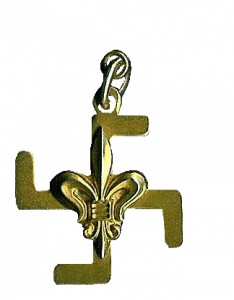

A rare 1913 Thanks Badge set in a circle, Kelvin Holford collection.
Part of reason for the rarity of this first badge is that it was in use for a relatively short time, probably less than six months. As it was merely a ‘swastika’, with no visual connection with the Scout Movement, it is not surprising that many would have been disregarded during the Second World War when the swastika came to be the most hated symbol in the world, and so reducing the number now available to collectors.
Later in 1911, the same basic ‘swastika’ with the addition of an applied very French looking ‘fleur’ became available in gold, silver and base metal. The gold was in most cases 9 carot though I have a 10 carot example which I think was the Canadian standard. This was not meanness, 18 carot gold is considered too soft-wearing for most jewellery. The different value of the metals, gold silver and base metal, which in later badges was replaced by brass, was perhaps meant to reflect the level of the support given by the recipient, or more likely his or her social standing. Britain was still a very class-ridden society in the Edwardian era. Whilst these distinctions might have seemed a good idea at the time the badge was introduced, it is doubtful that anybody would really want to give or to receive the lowest value badge and consequently they are very rare now and perversely worth more than the gold issue! The gold example on the right, still with its pin, was awarded to Mrs J E Wright,from 154 N.L., the abbreviation being neccessary because of the very the limited amount of space on which to engrave. I take N.L. to mean North London, but if any one can shed any light on this recipient, or group, we would be pleased to include the details here.
Very shortly afterwards the same badges were re-issued but with the ‘fleur’ being cast into the fylfot and not superimposed i.e. a one piece casting.

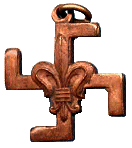
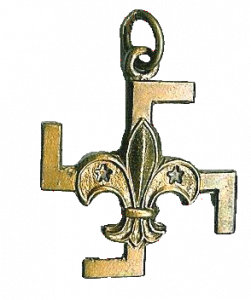
World Scout Historian Piet Kroonenburg in a companion article to this, on these Scouting Milestones, The Evolution of the World Scout Emblem , points out that the French Scout Association had asked the International Conference in 1922 to rule that the use of the words ‘Fleur’ and ‘Fleur de Lys’ be outlawed in connection with the Scout Badge. Scouting countries were asked to call the badge by another Baden-Powell term for it, that of ‘arrowhead, because many French people saw the ‘fleur’ as being the emblem of the deposed Bourbon Kings and as the symbol of a political party whose aims were to overthrow the Republic. Britain was a signatory at this conference, and had already decided to replace the lily design.
It was in 1920 that the ‘French looking fleur’ was replaced by the 1909 ‘Registered Design’ with the two five-pointed stars in the wings. The whole purpose of the Registered Design was to provide a unique emblem that could not be copied by others for commercial gain. The French Fleur de Lys was clearly a very ancient heraldic device and neither it nor the swastika could be protected as separate individual designs, but by placing one on the other it was thought sufficiently different to be separately registered. Its design number, as far as I can discern from the example above, is 556596. The stand alone ‘fleur’ or ‘arrowhead’ known worldwide as the badge of Scouting could only be protected by law if it was unique to Scouting. This was done by the addition of the two five-pointed stars, one in each side leaf of the ‘fleur’. Each of the ten points symbolises one of the ten Scout Laws (in 1908 there were only nine Scout Laws). It this unique combination of stars applied to an ancient symbol which enabled it to be copyrighted. The new ‘registered design’ fleur was at first superimposed on to the arms of the fylfot, and later in 1930 once again the same design was achieved with a single casting.
The Duty of Care
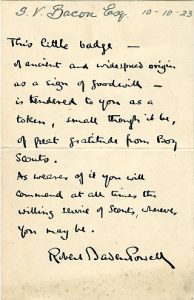 Stanley Bacon card
Stanley Bacon card
The recipients of Thanks Badges in the nineteen-twenties were informed of the significance of the badge and the duty of Scouts to its holders, on a little card which was presented with it. Boy Scouts were reminded in Scouting for Boys of their duty.
From What Scouts Can Do – More Yarns – Baden-Powell, 1921;
“There are a great number of people now who wear the Scout’s Badge of Thanks, and it would be a great disgrace to a scout(sic)if he let one of these people pass him without noticing it. . . what ever the origin was, the Swastika now stands for the badge of fellowship among Scouts all over the world, and when anyone has done a kindness to a Scout it is their privilege to present him or her with this token of their gratitude, which makes him a sort of member of the Brotherhood, and entitles him to the help of any other Scout at any time and at any place. I want specially to remind Scouts to keep their eyes open and never fail to spot anyone wearing this badge. It is their duty then to go up to such a person, make the scout sign, and ask if they can be of service to the wearer.”
This card, along with its badge, was presented to Stanley V Bacon in 1923. Stanley Bacon was a gold-medal winner in the 1908 London Olympic Games for Freestyle Middleweight Wrestling. His contribution to Scouting was, at the time of originally writing this article in early 2001, unknown to me. Then, in late 2003, a correspondent to Milestones, Chris Bate, told me of his discovery in an American journal promoting physical culture – Iron Game History. In the January 1993 issue, a letter was published from another British wrestling Olympian, Stan Bissell, who wrote that he started his wrestling career in about 1914/15, when he joined the Boy Scouts and his tutor was none other than Stanley Bacon. Unfortunately, the letter went into no further detail, but it seems to suggest that either Stanley Bacon was in the Boy Scouts in some official capacity, or that he provided coaching in wrestling as an instructor, perhaps for the ‘Master at Arms’ badge, or the Senior Scouts’ ‘Venturer’ badge. In any event it seems that Stanley Bacon well deserved his Thanks Badge. Should anyone ever encounter a photograph of him we would be pleased to display it here.
Later on an abbreviated version of the message was used, but of course when the ‘swastika’ badge was finally dispensed with, so was the card, and sadly the obligation of Scouts to assist those who were awarded the badge.
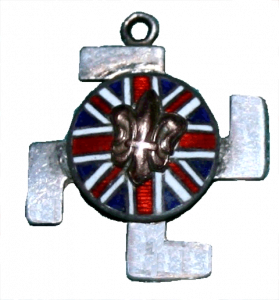
flag swastika
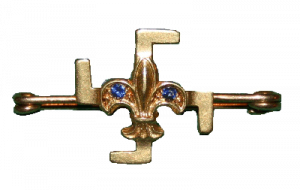
Jewelled swastika
The Thanks Badges illustrated to the left and right are from the collection of Kelvin Holford. The version (to the left) with the applied fleur against a circular background of the Union Flag is very rare indeed, I am aware of only one other example. It has not to my knowledge been dated. The tiepin to the right is as far as I know unique. Whilst the fleur would be appear to be the same as those used on the later issues with the two five pointed stars in the wings (in this case being used as ‘receptors’ for sapphires, it is I feel specially made having a more sculptural jewel-like quality. The notion of putting ‘jewels’ in the wings of the fleur is certainly not unique as there was a standard metal badge for ‘lady workers’ during the First World War which had the stars filled in with either green or blue enamel.
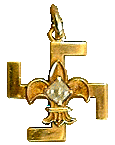
Kimberley Diamond Thanks Badge
Of course all Thanks Badges are unique in that they represent a unique contribution to the Movement however, surely the rarest, most valuable and most distinguished Thanks Badge ever given, outshining even those worm by Royalty, must be the one presented to Baden-Powell by the Boy Scouts of Kimberley on his World Tour in 1926. Kimberley, as you may know was the biggest source of diamonds in the world, and so it was thought fitting that the Founder’s Thanks Badge should have a diamond at its centre. It now resides in the Scout Archives at Gilwell Park, hopefully waiting the building of a U.K. Scout Museum where it can be given greater prominence.(Regrettably plans to have this completed for the Centennial Jamboree have not come to fruition, and it would appear no longer to be a priority.)
Other more mundane Thanks Badges were supplied in a variety of guises, to be worn on necklaces, as buttonholes, broaches and tiepins and, I would suggest, all have created far more good will than their initial cost could have ever purchased. “A good Scout leaves behind nothing but his thanks” and, as often was the case, The Founder showed his genius by insisting that all, not just uniformed members, who contributed to the greater good of Scouting who should be ‘rewarded’. I think it is just as wonderful an idea today as it ever was and would urge each and every Scout Group to look to the Founder’s instructions. “leave … thanks!” The present version of the Thanks Badge will do, it doesn’t have to have a diamond!
The Medal of Merit bore the ‘swastika’ device from 1928 to 1934 when a new Medal of Merit was issued in Great Britain and the Colonies. Any 1928 Fylfot design medals could be returned and exchanged for a new medal, or the holder could buy the new medal and keep the old. This is why it is possible to find pairs of medals of different designs with the same name and date.
The Medal of Merit
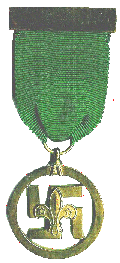
Swastika Merit Badge
When Baden-Powell redesigned the Medal of Merit in 1928, he superimposed the Scout emblem on the Swastika as good luck to the person receiving the medal. As the activities of National Socialist party began to have their impact outside Germany it became apparent that the ‘swastika’, as a Scouting emblem would have to go. Members of the National Socialist Party also, like Scouts, wore uniforms with brown shirts and any confusion between them and Scouting was most undesirable. During the 1930’s, letters of protest were sent to Scout Headquarters from British Scouters who had traveled abroad requesting a change of design for the Thanks Badge and the Medal of Merit. The Czech movement particularly could not abide the old design, and it was at this point that several member countries of World Wide Association decided to switch to their own national designs. Under this pressure,the Medal of Merit was changed in 1934 to a very similar design to that which we still have today; a cut out gold ‘fleur’ in a circle and, in 1935, the Thanks Badge altered to a short-lived but attractive design of a hand formed into a Scout salute, within a golden circle.(See image opposite ‘Acknowledgements’ below.)
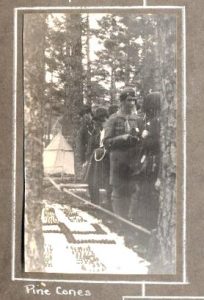
Swastika moitif Cruise of the Calgaric 1933
It is interesting to note that at the time of The Cruise of the Calgaric in August 1933 (The first of three ‘Peace Cruises’ jointly devised by the Scout and Girl Guides Associations), the National Socialist Party was well established Germany, as was the their use of the swastika. Their presence was so widespread that diarists on the voyage noted the obvious presence of “Nazis” officials at the German ports of call. Near Palanga in Lithuania however (an independent Country before being subsumed into the USSR, now thankfully since 1990 free again, the ‘cruisers’ joined a local jamboree held in the pine woods on sand hills next to the sea-shore. The whole assembly sat down for a meal together at a ‘table’ shaped like a giant spoked wheel, sitting on the ground with feet in a trench. The sand from the trenches had been used to raise the height of the ground to make the ‘table’, which was covered in white sand from the beach and shells, mosses and pine were used to make decorative panels. In the photograph opposite we see the swastika motif. This image is included here to prove that even at this stage the danger of the Nazi swastika ‘contaminating’ the Scouting image had not been fully recognised.
An Inglorious End
The German National Socialist party had adopted the swastika as early as 1920 and it became the national flag of Germany on 5th September 1935. They used a black, forward-facing Swastika on a white, circular ground as a symbol of the “Vocation to fight for the Victory of the Aryan race”. There seems to me to be one important difference between the Scouting symbol and the official Nazi emblem that ought to be sufficient for them never to be confused. The Nazi symbol has ‘legs’ that are set on diagonals i.e.’forward facing’, whereas the Scout symbol had its legs on a vertical/horizontal axis. This difference was highlighted by the Nazis themselves when they called their symbol “The forward facing wheel of prosperity.”

A pre-1914 book
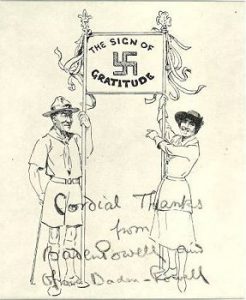
Card sent by the Baden-Powells
One of the oldest and most widespread good-luck symbols in the world has been so subverted that it can no longer be used. One wonders if it will ever be rehabilitated? I have seen young people (non-Scouts of course) with no particular political leanings use it as a fashion accessory, probably because of its power to shock. It is said that time heals most wounds. I am doubtful whether any of my countrymen, other than those who have made special study, would be aware of the icons of earlier wars that were feared in their time. Would any ill-feelings be invoked by looking at the uniforms of the men who the cut down the five hundred in the Charge of the Light Brigade or the badges of the Boers who fought the British at Spion Kop. Clearly whilst ever there are survivors or the direct descendants of those who died, the scourge of the swastika is not going to make a ‘come back’, particularly in those countries that were directly affected. I was though somewhat heartened on a visit to Nuremberg, Germany, visiting what remains of the infamous stadium where the Third Reich held many of its rallies, to find the steel door to its inner sanctum, used by Herr Hitler himself, had been spray-painted with graffiti. On that door, where so much hatred and destruction had opened out upon the world, there was neither pro or anti-Nazi slogans, merely the universal heart sign between ‘Andreas’ and ‘Babsi’. Perhaps there is hope for the world yet!
The mainland of India provided troops for the Second World War, but I think I am correct in saying that most of the population were not touched by its horrors. As the continent that perhaps enjoyed the longest and most widespread use of the symbol they saw no reason to relinquish the symbol and so it remains popular to this today.
Of more immediate concern is the fact that I have seen auctions on eBay for Scouting items incorporating a description, where the vendor, presumably in ignorance, has made an association between Nazism and Scouting! The time spent producing these pages will have been worthwhile if they can help dispel any unhelpful associations in Scouting’s proud tradition and give present-day Scouts a better idea of their Scouting Heritage.
